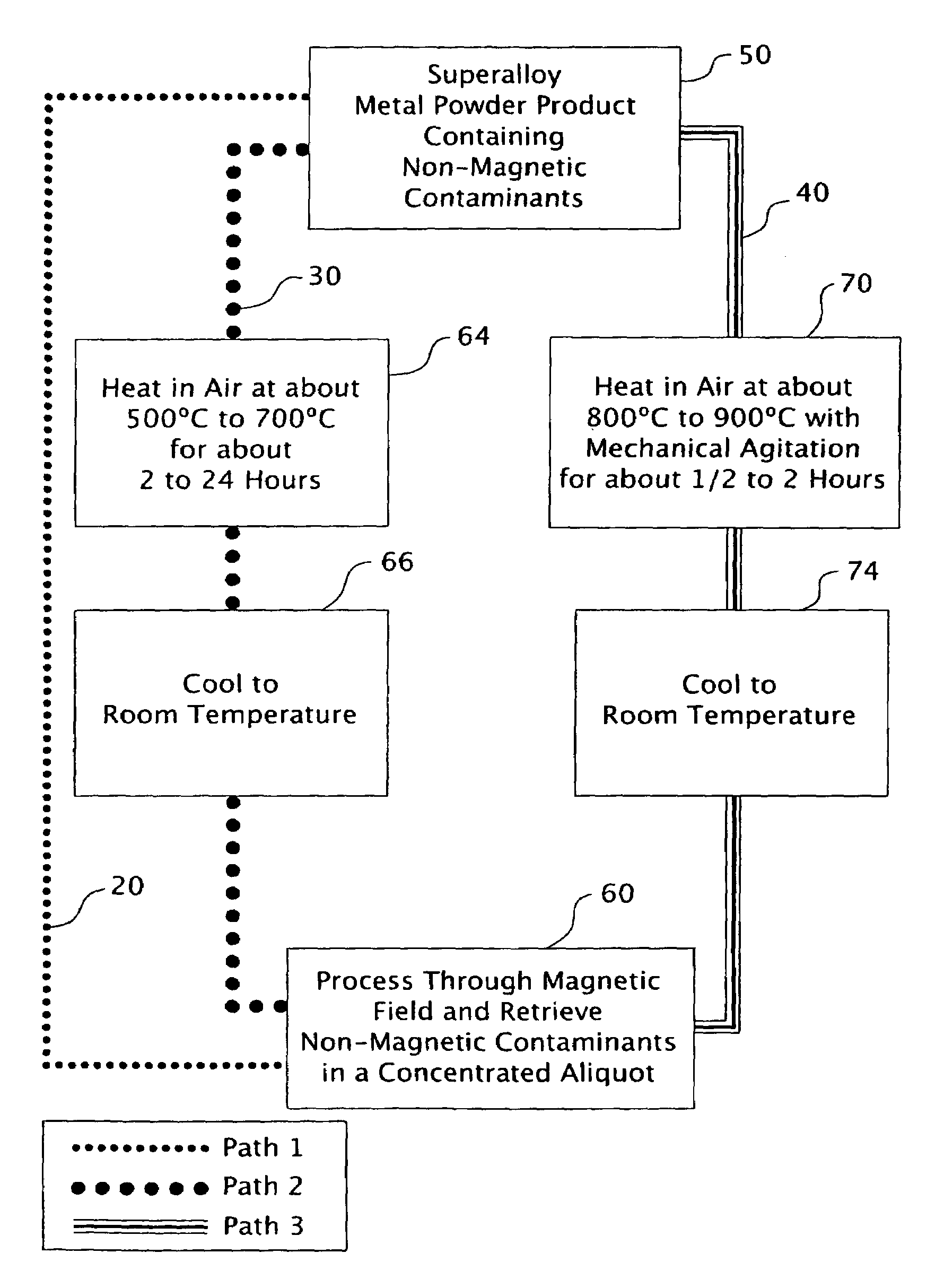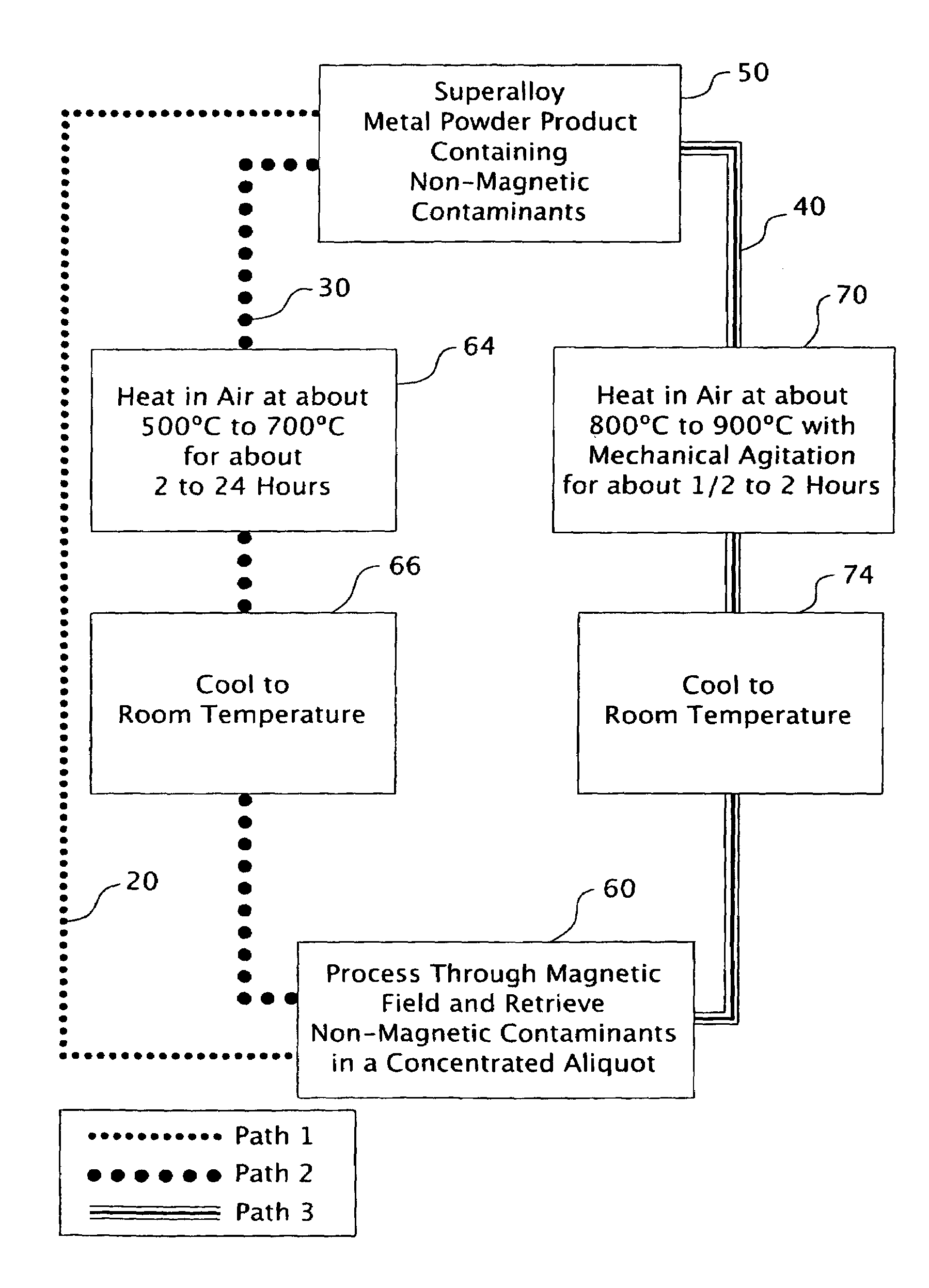Method of separating superalloy metal powder from admixed contaminants
- Summary
- Abstract
- Description
- Claims
- Application Information
AI Technical Summary
Benefits of technology
Problems solved by technology
Method used
Image
Examples
example 1
[0043]A superalloy metal powder with a nominal composition of 14% Cr, 8% Co, 3.5% Mo, 3.5% W,<3.5% Nb, 3.5% Ti, 3.5% Al, and balance Ni, and a particle size of −270 mesh was heated in air at a temperature of 900° C. for a total of one hour and cooled to room temperature. During heat treatment, the powder was removed from the furnace every 15 minutes and agitated (stirred) to resist agglomeration. Magnetic measurements of the powder showed that it was weakly paramagnetic before heat treatment, but was ferromagnetic after the heat treatment. The powder was passed through a belt-type magnetic separator employing a field strength of 24,000 gauss and because of the substantially enhanced magnetic properties of the metal alloy powder, the non-magnetic contaminants were readily separated therefrom.
[0044]Separation efficiency was excellent at a level exceeding 90% with only one pass through the separator.
example 2
[0045]Metal powder with the characteristics of the powder of Example 1 and in the non-heat-treated condition was passed through the belt magnetic separator with the aforementioned high-field strength of 24,000 gauss. The metallic particles in the as-received metal powder product are only feebly magnetic. While one pass through the separator resulted in some separation of the non-magnetic contaminants from the alloy powder, separation efficiency was about 30%. Multiple passes through the separator would be required to increase the efficiency to acceptable levels.
example 3
[0046]Metal powder with the characteristics of the powder of Example 1 was heated in air for 24 hours at 500° C. and another batch for two hours at 600° C. Magnetic measurements showed that both powders had become moderately paramagnetic. Furthermore, at these temperatures and times essentially no agglomeration of the powder was observed. Heat treatment at these relatively low temperatures could be used to obtain magnetic separation efficiencies substantially higher than that for as-produced powder of path 20.
[0047]The magnetic properties of the metal particles may be enhanced by altering the composition of one or more regions within the metal particles.
[0048]It is believed that enhanced magnetic properties may be effected in superalloy metal powder by removing chromium from the metal matrix as by oxide formation or leaching, for example. Also, phase transformation may be employed to enhance magnetic properties.
[0049]It will be appreciated that the present invention has provided a s...
PUM
| Property | Measurement | Unit |
|---|---|---|
| Temperature | aaaaa | aaaaa |
| Temperature | aaaaa | aaaaa |
| Temperature | aaaaa | aaaaa |
Abstract
Description
Claims
Application Information
 Login to View More
Login to View More - R&D
- Intellectual Property
- Life Sciences
- Materials
- Tech Scout
- Unparalleled Data Quality
- Higher Quality Content
- 60% Fewer Hallucinations
Browse by: Latest US Patents, China's latest patents, Technical Efficacy Thesaurus, Application Domain, Technology Topic, Popular Technical Reports.
© 2025 PatSnap. All rights reserved.Legal|Privacy policy|Modern Slavery Act Transparency Statement|Sitemap|About US| Contact US: help@patsnap.com


